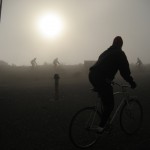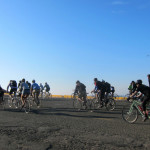“A writhing, restless throng packs Delhi’s streets. Masses of people crowd every inch of available pavement and it seethes with their energy.”
“The traffic hierarchy in India reminds me of chess match, in that it requires a lot of strategy and forbearance — as least to a tourist. Cows are the kings and have total freedom. (One of Rishi’s friends said to me, “I’d like to reincarnate as a cow and not a dog if I come back in another life to India, and the reverse if I’m in the U.S.”)
Then buses, due to their size, come next, then wagons, taxis, cars, autorickshaws, mopeds, rickshaws, bicycles and lastly pedestrians. Of course, pedestrians, like pawns, have the power to capture a queen if they’re in the position to do so. So there’s a constant jockeying amongst all of the players for forward movement. Everyone is incessantly honking in order to signal they’re barreling ahead. All of the trucks have signs hanging above their bumpers that say, “honk please,” to encourage this noisy communication. Indian car horns are not the aggressively loud sounds like you’ll find in the U.S.; they’re short, endearingly cute beeps that make them sound like toy cars. But as there are hundreds upon thousands of them all sounding off at once, the din is extraordinary.”
“The trucks all seem to be manufactured by two companies: TATA or Ashkok Leland. And the backs of the vehicles are festooned with brightly painted murals, some of which are quite ornate and feature peacocks, cows and other animals.”
“Our favorite rickshaw driver was from Jaipur, a chatty 17-year-old teenager who spoke English rather well. He insured we became his regular customers by always waiting for us outside of our hotel, restaurants and other stops.”
—Journal Entries From My Trip to India in 2004







